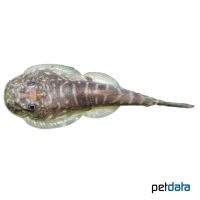Myer's Hillstream Loach (Pseudogastromyzon myersi)
| Myer's Hillstream Loach Pseudogastromyzon myersi | |
|---|---|
| Name | Myer's Hillstream Loach |
| Name Lat. | Pseudogastromyzon myersi |
| Family | Hillstream Loaches |
| Family lat. | Gastromyzontidae |
| Order | Carps |
| Order lat. | Cypriniformes |
| Origin | SE-China, Hong Kong |
| Habitat | Mountain streams |
| Diet | Limnivore |
| pH | 6.5-7.5 |
| Behavior | Peaceful |
| Keeping | Group |
| Care Level | Difficult |
| Reproduction | Cave spawner |
| Breeding | Difficult |
| Life Span | 4-7 years |
| Protection | No |
| Metric Units | |
| Size | 5 cm |
| Temperature | 20-24 °C |
| Hardness | 5-10 °dH |
| Aquarium | ~ 80 l |
| US Units | |
| Size | 2" |
| Temperature | 68-75 °F |
| Hardness | 89-178 ppm |
| Aquarium | ~ 20 gal |
Distribution and habitat
The Hong Kong fin sucker is widely distributed in southeastern China, Guangdong Province and Hong Kong. They live in fast-flowing, oxygen-rich mountain streams and river headwaters, preferring shallow water, among rocks, boulders and round river pebbles densely covered with algae.
Maintenance
The aquarium should have robust planting, strong lighting, a substrate of sand and round-grained gravel, large rounded stones and roots (hiding places). They need oxygenated water and a very strong current.
No ammonia, ammonium and nitrite should be detectable, the nitrate value should not exceed 100 mg/l. To ensure the water quality and oxygen content, a filter and heater adapted to the aquarium size is required, as well as lighting for the species-appropriate day-night rhythm of the animals.
Diet
They eat the plant cover (growth) of stones and wood and the microorganisms contained therein. For a balanced diet, feed them once a day with a high-quality sinking dry food (granules, tablets) as well as cyclops, daphnia or mosquito larvae (live or frozen). In addition, they need vegetable food, such as crushed peas, scalded spinach or algae leaves. It is recommended to coat stones or roots with a slurry of spirulina, chlorella and other algae powder and place them in the aquarium after they have dried
Only feed as much as will be eaten within a few minutes. A regular and varied diet promotes health and increases resistance.
Behaviour and compatibility
They are active and very peaceful fish that can be kept well with other peaceful fish. At least 5 Hong Kong fin sucker should be kept together.
Basically, only compatible fish species with similar requirements for water conditions and water temperature should be socialized.
Sex dimorphism
Females are larger and plumper than males and their markings are less contrasting
Reproduction and breeding
The female lays the eggs in a pit dug by the male. After the male has fertilized the eggs, he covers the pit with substrate. There is no brood care. After 4-14 days, the fry, which are about 10 mm in size, hatch and immediately begin to graze on growth.
Breeding is hardly possible in a community tank, as the fry are easy prey.
Important
According to their origin, Hong Kong fin suckers can vary in color and pattern and are easily confused with the Chinese fin sucker (Pseudogastromyzon cheni).
They have large pectoral and pelvic fins, which are designed as adhesive organs that allow them to attach to rocks in fast-flowing waters. When changing location, they swim only short distances, quickly and shallowly above the bottom, to immediately reattach themselves.
The well-being of the fish should be checked regularly. Temperature should be checked daily, pH, hardness and nitrate levels should be checked at least every 14 days. Regular partial water changes are recommended, even if the pollutant load has not yet reached the upper limit. Sudden changes in water quality should be avoided. Newly introduced fish must be accustomed slowly to the water in the aquarium.
Further literature can be found in your pet store.
References
Text: Werner Winter; Image: petdata
Source: BMELV (1998): Tierschutzgutachten - Haltung von Zierfischen (Süßwasser); BAENSCH & RIEHL (2004): Aquarien Atlas Bd. 2, Mergus Verlag; ENGELMANN (2005): Zootierhaltung - Tiere in menschlicher Obhut: Fische, Verlag Harri Deutsch
- Gemäß § 21 Abs. 5 Tierschutzgesetz idgF
